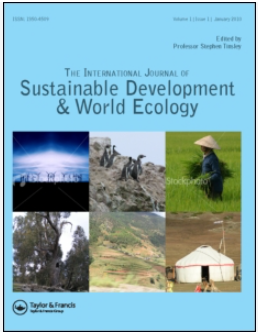基于多情景模拟的西北干旱半干旱区生态安全格局构建
IF 7.7
3区 环境科学与生态学
Q1 ECOLOGY
International Journal of Sustainable Development and World Ecology
Pub Date : 2023-03-03
DOI:10.1080/13504509.2023.2185914
引用次数: 0
摘要
生态安全模式对区域发展规划和战略具有重要意义。然而,关于未来情景下ESP潜在变化的研究很少。考虑到不同的气候和自然地理条件,需要对esp的建设进行更多的研究,特别是在高海拔、干旱和半干旱地区。本研究通过模拟库车-沙雅-新河地区未来多情景土地利用变化,构建库车-沙雅-新河地区历史和未来生态系统,填补了文献的空白。结合最小成本路径和电路理论,综合生态连通性和研究区域数据,识别生态源,建立生态阻力面,识别生态廊道和生态节点。设计了惯性发展、生态保护和协调发展三种发展情景。结果表明,综合框架是研究多情景土地利用变化对生态系统影响的理想框架。在惯性发展情景下,生态资源面积明显减少,生态廊道、夹缝点和屏障点增加,生态工程建设负担较大。中短期应优先考虑协调发展方案,既能保证经济增长和基础设施建设,又能最大限度地减少未来生态工程建设的负担。研究结果为深入了解土壤电通量对土地利用变化的响应提供了依据,可为干旱半干旱区的保护与恢复提供参考。本文章由计算机程序翻译,如有差异,请以英文原文为准。
Construction of ecological security patterns based on multi-scenario simulations in arid and semi-arid areas in Northwest China
ABSTRACT Ecological security patterns (ESPs) have several implications for regional development planning and strategies. However, there have been few studies on potential ESP changes in future scenarios. Considering the various climatic and physical geographical conditions, more studies on the construction of ESPs are needed, particularly in high-altitude, arid, and semi-arid regions. This study fills a gap in the body of literature by simulating future land-use changes under multi-scenario and constructing historical and future ESPs for the Kuqa-Shaya-Xinhe region. This study integrated ecological connectivity and study area data, identified ecological sources, established ecological resistance surfaces, and identified ecological corridors and nodes by combining least-cost paths and circuit theory. Three development scenarios (inertial development scenario, ecological conservation scenario, and coordinated development scenario) were designed. The results showed that an integrated framework is ideal for investigating the spatial and temporal impacts of multi-scenario land-use change on ESPs. Furthermore, under the inertial development scenario, the area of ecological sources decreased significantly and the increased ecological corridor, pinch, and barrier points suggested that a large burden of ecological engineering construction is expected. By contrast, the coordinated development scenario should be preferred in the short and medium term as it can ensure economic growth and infrastructure construction while minimizing the burden of future ecological engineering construction. Our results provide a deeper understanding of the response of ESPs to land-use change and can provide references for the protection and restoration of arid and semi-arid areas.
求助全文
通过发布文献求助,成功后即可免费获取论文全文。
去求助
来源期刊
CiteScore
11.10
自引率
3.60%
发文量
58
审稿时长
18-36 weeks
期刊介绍:
The International Journal of Sustainable Development and World Ecology is now over fifteen years old and has proved to be an exciting forum for understanding and advancing our knowledge and implementation of sustainable development.
Sustainable development is now of primary importance as the key to future use and management of finite world resources. It recognises the need for development opportunities while maintaining a balance between these and the environment. As stated by the UN Bruntland Commission in 1987, sustainable development should "meet the needs of the present generation without compromising the ability of future generations to meet their own needs."

 求助内容:
求助内容: 应助结果提醒方式:
应助结果提醒方式:


